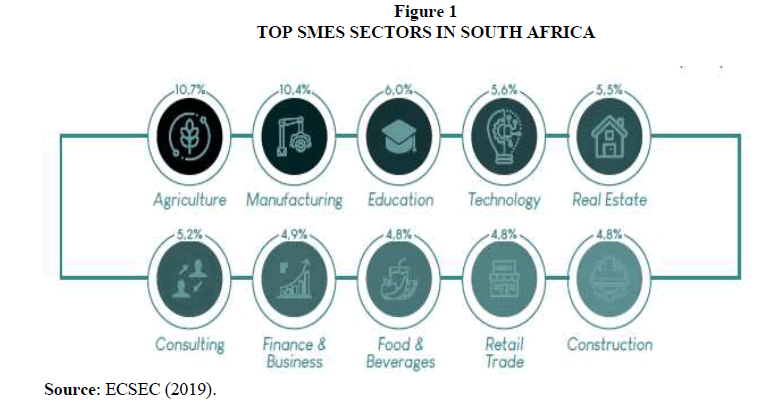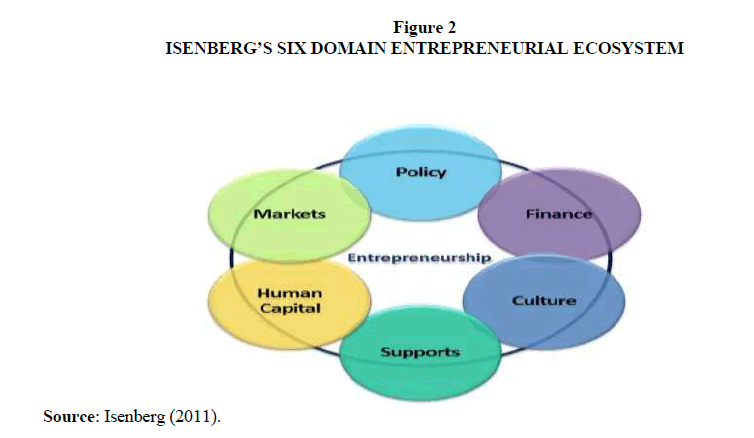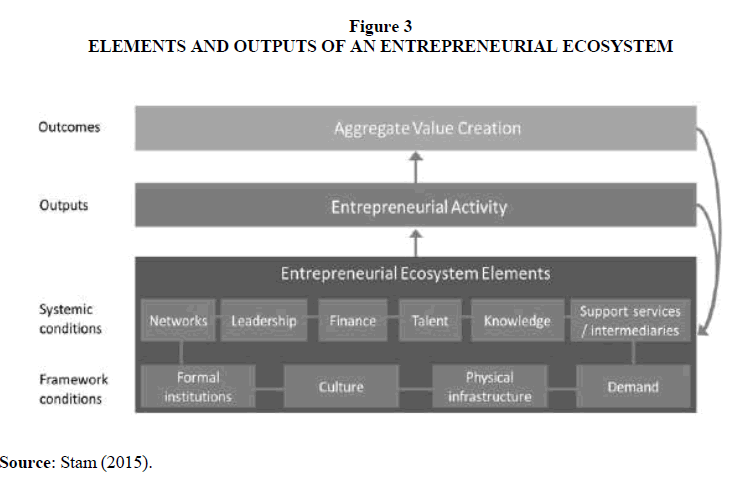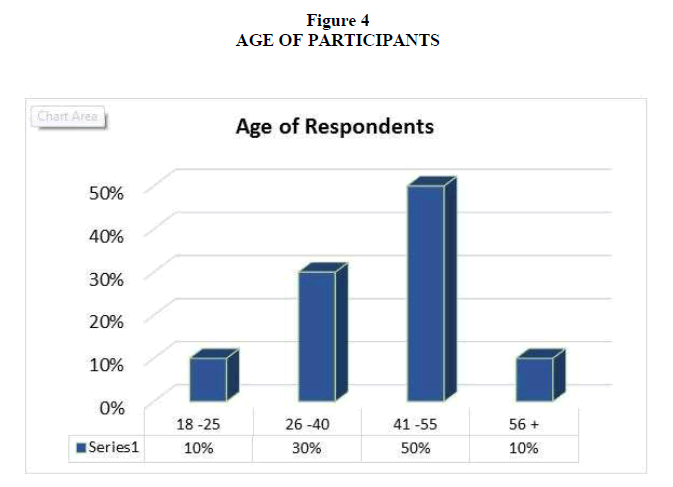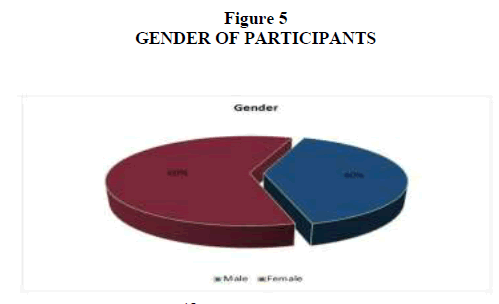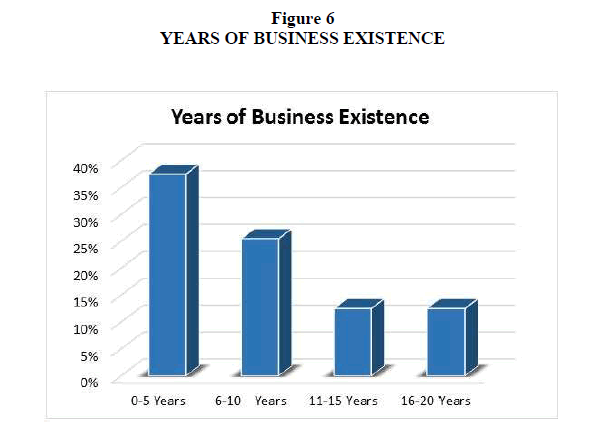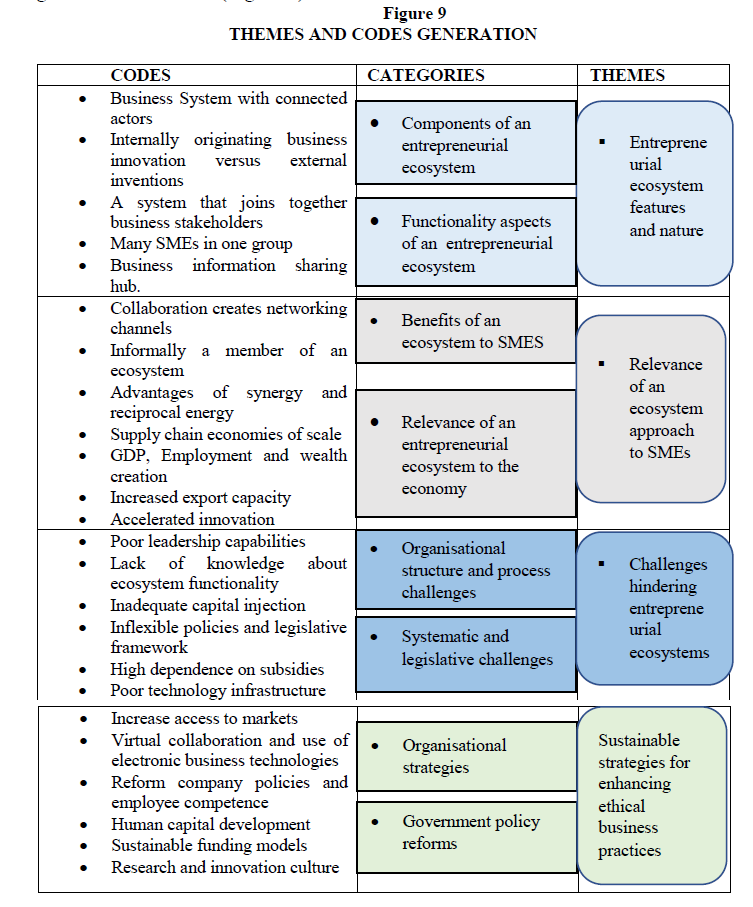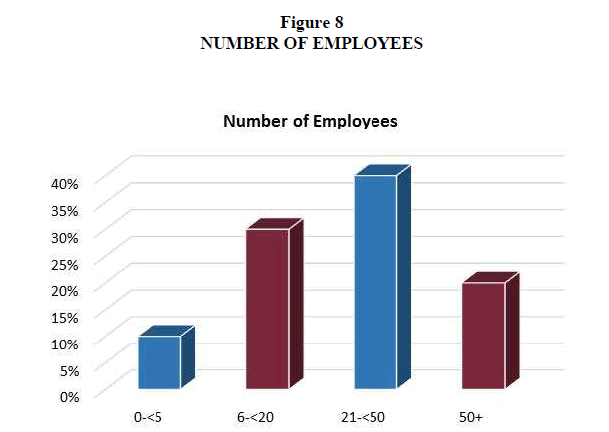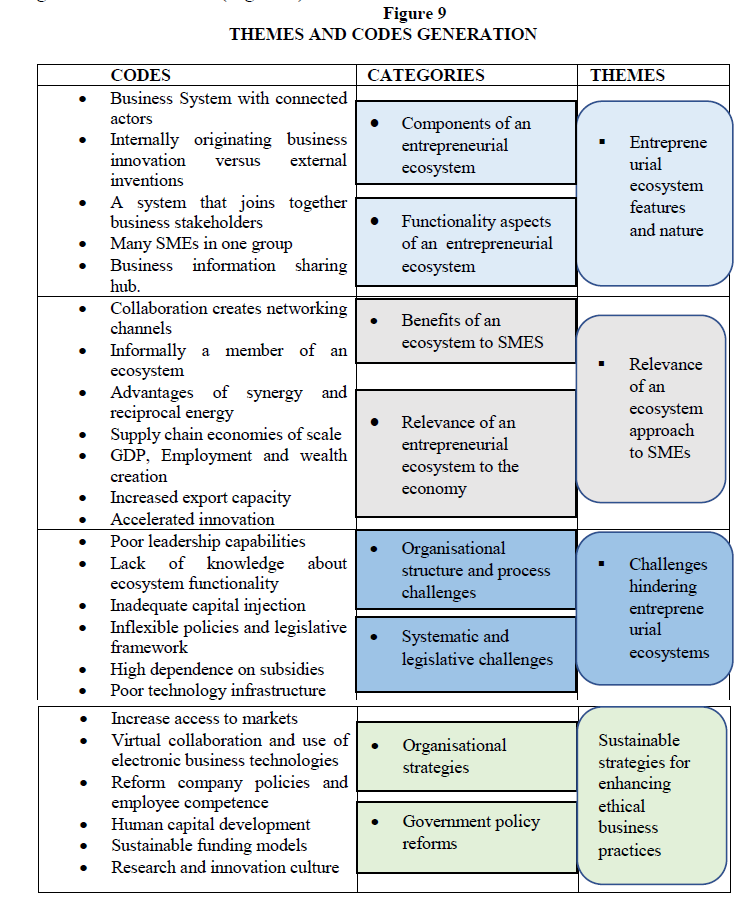Research Article: 2023 Vol: 29 Issue: 5
Examination of the Dynamics of a Sustainable Entrepreneurial Ecosystem towards Enhancing SME Development in a Selected Metropolitan Municipality in the Eastern Cape
Viwe Mrwebi, University of South Africa
Patrick Mawila, Buffalo City TVET College
Citation Information: Mrwebi. W., & Mawila. P. (2023). Examination of the dynamics of a sustainable entrepreneurial ecosystem towards enhancing SME development in a selected metropolitan municipality in the eastern cape. Academy of Entrepreneurship Journal, 29(5), 1-22.
Abstract
The new South Africa, post the Apartheid dispensation has been characterized by numerous economic challenges among them redressing economic and social imbalances. SMEs performance evidence from the past suggests that while money is important on fueling SMEs development, incubation of small businesses from inception to full growth stage is even more crucial. Studying the entrepreneurial ecosystem in the BCMM is imperative in devising bankable solutions through a holistic approach. In the past few decades, the evolution of small development philosophies resulted in the conception of the idea of the SMEs ecosystem. The current study was conducted with the main aim of examining the dynamics of a sustainable entrepreneurial ecosystem towards enhancing SMEs development in BCMM.
This study was guided by an interpretive research paradigm necessitating the use of a qualitative research approach. In terms of the research design, this study employed an exploratory type of a research design. The targeted respondents comprised of 10 SME owners and managers from the BCMM area. Questionnaires were used for recording responses. The questionnaire was semi-structured, combining closed-ended options with a few open-ended options. Primary data collected in this study was cleaned and coded before undergoing further analysis. Based on the exploratory research design, the study made use of thematic analysis as the chosen technique.
Findings from this study are a combination of literature analysis and primary data collected from this study. From the analysis, it was evident that an ecosystem plays a crucial role in bringing together stakeholders with the objective of improving business performance. It also came out that an entrepreneurship ecosystem operates on similar principles as those that function in a biological system. Business ecosystems are important because they serve as a networked of relatively free collaboration between several companies from one or more industries. It was fundamental for the researcher to gain understanding of the functionality elements of the ecosystem. Respondents revealed that an entrepreneurship is built on principles of the natural ecosystem; they must serve to store, convert and share information.
Keywords
Development Philosophies, Entrepreneurial Ecosystem, Business Ecosystems
Introduction
In the past few decades, the evolution of small development philosophies resulted in the conception of the idea of the SMEs ecosystem. In a natural ecosystem, living organisms are interdependent, store and pass energy among each other. This means therefore, the entrepreneurial ecosystem was derived from the organic version and comprises of SMEs and various supporting structure which coexist with a businesses such as the government, financing institutions among others. In addition, Like any individual species in a biological ecosystem, each member of an entrepreneurship ecosystem provides unique attributes that work together positively in an entrepreneurial ecosystem. The systems of innovation approach emphasize the importance of interactions among different kinds of actors and technology policy for innovation success. The term innovation ecosystem was coined to describe an ecosystem through which organisations development is divisible in three groups. The classes include influence of individual factors, influence of environmental factors success and entrepreneurship performance on entrepreneurial success and development (Carvalho, 2017). The literature of entrepreneurship ecosystem is belonging to the third group. Approaches of entrepreneurship ecosystem have focused on various elements for entrepreneurship development in a region (Cooper & Schindler 2014; Pugh, 2021).
Furthermore, Small to Medium Enterprises serves as an important nerve in the improvement of the production capacity of an economy. The definition of SMEs varies across different countries world-wide and so is the case with South Africa. The definition of SMEs in South Africa is largely dictated by the constitutional provisions and legislative pieces enacted in the republic (Celik, 2018). The classification of SMEs in this study is derived from the South African Small Business Act 102 of 1996 which defined small businesses in quantitative and qualitative perspectives. Small to medium businesses may be categorised in terms of the sector, number of employees, total gross asset value, and turnover. The quantitative definition suggests that SMEs are businesses that have not more than 201 and the turnover does not exceed R50 million (Vuba, 2019).
Carvalho (2017) explored new venture creation within the context of an entrepreneurial system. The key to sustainable entrepreneurship lies in the specific combinations of the elements in an entrepreneurial ecosystem. Ecosystems are highly dynamic and interactive, with varied and inter-dependent actors. In the ecosystem, incubator organizations, informal and formal networks, technology and culture are related uniquely to form a system conducive for entrepreneurial activity. In another study, Mpele Lekhanya, Grace Olajumoke and Nirmala (2017) revealed that an entrepreneurship ecosystem is built on pillars which include the government, culture, Human capital, financial capital, entrepreneurship organization, economic clusters, networks, support services and customers.
Consequently, entrepreneurial ecosystems usually develop in regions that are endowed with place specific assets and networks. Creating self-sustaining ecosystems is an ingredient for sustained businesses growth because entrepreneurship in new sectors supersedes firms in older sectors within the local ecosystem (Malecki, 2018). Employing the ecosystem approach to improve the quality of entrepreneurship and growth of SMEs is expected to address the challenges of regional economic development, as well as increase local competitiveness. Thus, it is necessary to devise a concept that delineates the role of entrepreneurship and the manner in which its interaction with other actors within the entrepreneurial ecosystem affects local SMEs competitiveness. The generalized view about SMEs is that they originate from certain geographical regions. This perhaps, it is appropriate only for regions which already have a critical mass of new firms. More comparative research is needed on ecosystems at various stages of development. The section below presents the research problem of the study.
Problem Statement
The new South Africa, post the Apartheid dispensation has been characterized by numerous economic challenges among them redressing economic and social imbalances. The country has progressed with various economic development policies, patching up the various holes on the canvas of its economy. Amongst the core problems bombarding South Africa this include unemployment and income disparities which need urgent attention. However, to curtail the perpetual challenges that have been prevalent is South Africa; the economy needs to empower masses at a cellular level, beginning with enhancing SMEs development.
SMEs performance evidence from the past suggests that while money is important on fueling SMEs development, incubation of small businesses from inception to full growth stage is even more crucial. Studying the entrepreneurial ecosystem in the BCMM is imperative in devising bankable solutions through a holistic approach (ECSEC, 2021).The government of South Africa has demonstrated its desperate need for small businesses in the country to take successfully off but there still remains enumerable inhibiting factors.
The selected Metropolitan Municipality area is among the major zones with high SMEs concentration in the Eastern Cape region. According to ECSES (2020) latest report, the Eastern Cape Province of South Africa boasts with more than 151 000 formally registered SMEs, with at least 41,000 located in the BCMM area. However with such staggeringly high figures of registered small to medium sized businesses, the failure rate of the SMEs remains above 70% (Anwana & Anwana, 2020). The effectiveness of SMEs support ecosystems in the regions remains questionable and the need for improvement cannot be overlooked. This study seeks to close the gap in previous studies and explore the dynamics of entrepreneurial ecosystems, examining possible ways of enhancing small business development in the BCMM.
Literature Review Of The Study
Clarification of Key Concepts
Literature Review
Global overview of SMEs: While large corporations employ large numbers of employees, the combined number of those employed by formal and informal sectors remains very high in developing countries.
The statistics for developing economies shows that over 40% of the national income (GDP) comes from the small to medium sized enterprises. When SMEs in the informal sector are taken into account, the total contribution of SMEs to the GDP raises even higher (ECSEC, 2021). An estimated figure of 600 million jobs will be needed by 2030 to absorb the fast growing world’s workforce, rendering SMEs a priority, particularly for emerging economies. Chimucheka (2013) revealed that at least 70% of the new job opportunities that open up in the emerging markets, most of these jobs are generated by SMEs. The existence of an efficiently working entrepreneurial ecosystem in developed countries is a distinctive feature that creates the huge gap in the success rate of SMEs between countries in the wealthier parts of the globe against those in poorer economies. The context of this study is delineated around the Eastern Cape Province.
The rationale for promoting SMEs: The productive capacity of an economy can be improved by effectively building a support structure. At every level of the economy, productive resources can be absorbed, leading to the creation of an economic system that is resilient (Spigel & Stam, 2020). Furthermore, small to medium enterprises are credited for creating opportunities for the population layers which would otherwise not access certain opportunities in large corporations. With most large enterprises downsizing, the demand for employees in the formal economy has reduced alike. A large number of job seekers who cannot find work in the formal sector, SMMEs absorb a large number of employees. Owing to the fact that SMMEs employ unskilled and semi-skilled employees, they tend to take in more workers compared to the case with large businesses (Brownhilder, 2019). In South Africa, the government has identified SMMEs as a key to poverty alleviation. SMMEs are creating markets that are generally more accessible to the poor. The production processes provided by SMMEs combine the resources of societies efficiently to produce goods and services for the society in which they operate. SMMEs are expected to close the income gap that was created by decades of unfair resource distribution (Bryman & Bell, 2011; Spigel & Stam, 2020).
The entrepreneurial ecosystem: An entrepreneurship ecosystem operates on similar principles as those that function in a biological system. It is made up of such elements as markets, policies, funders, regulators and cultural factors among other elements. It is noted by Carvalho (2017) that the existence of large companies in a particular area plays a huge role in the development and success of an ecosystem. The law of numbers suggests that the openness small organizations among business and with consumers will be crucial. The information management policies of a family are very important Entrepreneurial ecosystems are also rich in information. Hence the environment allows individuals to access information and knowledge about new buyer needs, new technologies, operating or delivery possibilities, perceive gaps in products, services or suppliers to fill.
The success of SMMEs is also determined by the norms, culture and values established within their relationship networks. An ideal ecosystem must have an embedded culture of sharing resourcing and mostly information. The existence of a reliable source of finance is regarded by ECSEC (2021) as being an essential ingredient to the entrepreneurship ecosystem. Furthermore, every small business needs specialized and expert services from various service providers in order for it to do well. Professionals such as accountants, lawyers, engineers and architectures serve an important role in an entrepreneurial ecosystem.
An overview of entrepreneurship and SMEs: The success and growth of small and medium enterprises is fundamentally dependent on the human capital of their owner-manager in an entrepreneurial climate. However, Issues abut characteristics and traits that make a successful entrepreneur have received extensive attention from various researchers and has been extensively researched over the past decades and years (Anwana & Anwana, 2020). The study of entrepreneurial traits’ has gained great relevance, not only in the South African context, but in the world and the universe at large. Research in the entrepreneurial personalities has shown that most successful entrepreneurs share a definite group of personality traits (Fonger, 2017). Consequently, although there are agreements and consensuses amongst the researchers regarding the relevance of an entrepreneur’ traits, there remains a great contention regarding the degree of importance among these identified entrepreneurial characteristics.
In addition amongst others, the five most important entrepreneurial factors that have been identified as relating to successful entrepreneurs include and are primarily based on innovation, futuristic mindset, risk taking ability, adaptability and commitment (Ullah, 2019). Furthermore, Qureshi (2018) envisaged and extended on the idea by postulating that not all entrepreneurs are the same, and are indeed not homogenous in their entrepreneurial endeavours. It is however important to recognize that every entrepreneur must have both of innovation and risk taking propensity (ECSECC, 2021) in order to fulfil various needs and reach their full potential.
Furthermore, The macro-environment in an economy encompasses factors that are external to the organisation that are situation related variables and these variables play a major role in encouraging entrepreneurial activities or acting as entrepreneurial inducements in the process (Fonger, 2017). South African SMEs are led by entrepreneurs who have the essential key traits that are related to any entrepreneurial activity and are not immune to the forces inherent in the macro environment. The entrepreneur’s background, education, business concept or personality does not exempt them from being impacted by these macro-economic forces (Ullah, 2019). This means therefore, macro-economic factors cannot be controlled by SME managers and the very growth and success of the SME hinges heavily and largely depends on how well management navigates through these factors in achieving the goals and objectives.
Global SMEs Outlook
According to the World Bank (2020), SMEs are the original sources for numerous large businesses that exist around the world. In addition, the small to medium sized enterprises create millions of jobs for semi-skilled employees, reduce poverty among poor communities and contribute to the greater development of regions across the globe. While large corporations employ large numbers of employees, the combined number of those employed by formal and informal sectors remains very high in developing countries.
The statistics for developing economies shows that over 40% of the national income (GDP) comes from the small to medium sized enterprises. When SMEs in the informal sector are taken into account, the total contribution of SMEs to the GDP raises even higher (ECSEC, 2021). An estimated figure of 600 million jobs will be needed by 2030 to absorb the fast growing world’s workforce, rendering SMEs a priority, particularly for emerging economies. Chimucheka (2013) revealed that at least 70% of the new job opportunities that open up in the emerging markets, most of these jobs are generated by SMEs. The existence of an efficiently working entrepreneurial ecosystem in developed countries is a distinctive feature that creates the huge gap in the success rate of SMEs between countries in the wealthier parts of the globe against those in poorer economies (Fonger, 2017). The context of this study is delineated around the Eastern Cape Province.
The Status of SMEs in South Africa
In South Africa, the Ministry of Small Business Development (MSBD; 2020) recognizes that SMEs are crucially important in attaining sustainable development. According to Malecki (2018) SMEs are arguably the venue where a significant proportion of entrepreneurial activity occurs. This is supported by the statistics from ECSEC (2021) which reveals that at least 97% of the existing large businesses in South Africa have their origins in SMEs, contributing to further business creation. The figure below shows the industries in which most of the SMEs in South Africa are largely invested in (Figure 1).
The figure above shows that the greatest proportions of SMEs in South Africa are clustered in the Agricultural and manufacturing sectors, accounting for over 21%. The finance, retail and construction industries remain highly dominated by large firms and less attractive to most small business starters. The education and real estate sectors are moderately growing and promising. Small and medium enterprises in South Africa, much like the rest of the world, are exposed to systemic factors. These systemic factors include contractual and informational frameworks and macroeconomic environment, social factors such as crime, corruption and ethics, technology and the regulatory environment (Fonger, 2017). High interest rates, low growth rates, high inflation rates and declining exchange rates are but a few macro- economic factors that are currently affecting the South African economic environmental climate. General investor confidence and consumer consumption have both decreased in South Africa over the past recent quarters, resulting in firms getting reduced sales. In addition, the current South African unemployment rate is at an all-time high. These aforementioned macro environmental factors have greater propensity to adversely affect sales, revenues, market potential and any expansion plans of new and existing SMEs (Ullah, 2019).
SMEs legislative tools in South Africa
The National Development Plan of South Africa recognizes SMEs as being an important avenue through which the 2030 objectives can be achieved. Along with numerous policies, the government of South Africa has enacted a variety of laws that govern business development. The legislative framework was put in place to create a conductive environment for the promotion of small business development in South Africa (EDSE, 2017). Furthermore, the legislative framework eliminates the monopoly power of large enterprises, paving a way for the new entrants.
In 1991, the Business Act of 1991 was introduced to promote the development of businesses in South Africa; this was then followed by the National Small Enterprise Act of 1996. In year 1998, the Skills Development Act was introduced with the aim of broadening the skills and knowledge of previously disadvantaged groups (Fereday & Muir-Cochrane, 2006). Additional steps towards the inclusiveness of Black people into the main stream economy led to the enactment of the Preferential Procurement Policy Framework Act of 2000 which was supported by the Broad-Based Black Economic Empowerment Act of 2003 (Figure 2). Other additional legislation pieces include the Cooperatives Development Act of 2005, the Companies Act of 2008 and the National Small Enterprise Amendment Bill 2020.
Some environments are more conducive for the creation of entrepreneurial ecosystems compared to others. This means therefore the elements such as industrial culture and traditions tends to attract bigger businesses which provide spill over advantages to smaller enterprises.
It is envisaged by Carvalho (2017) that the existence of large companies in a particular area plays a huge role in the development and success of an ecosystem. Additionally, large companies can also give several other contributions, including the provision of space and resources for local start-ups, the creation of programs to support start-ups and the development of companies that improve their own eco-systems Isenberg (Vuba, 2019). The law of numbers suggests that the openness small organizations among business and with consumers will be crucial. The dynamics of the modern world are however that most entrepreneurs are open to constructive criticism and many of them are less English literate. and stresses that with the ‘law of small numbers’ that only a handful of entrepreneurial successes are needed to have major benefits for the ecosystem with spill over effects in terms of role models, serial entrepreneurs, angel investors, venture capitalists, board members, advisors and mentors (Manolova, et al. 2017; Molo, 2019).
The information management policies of a family are very important entrepreneurial ecosystems that are also rich in information. Hence, the environment allows individuals to access information and knowledge about new buyer needs, new technologies, operating or delivery possibilities, perceive gaps in products, services or suppliers to fill (Creswell, 2014).
Furthermore, the success of SMEs is also determined by the norms, culture and values established within their relationship networks. An ideal ecosystem must have an embedded culture of sharing resourcing and mostly information. Most SMEs do not try to rise up after experiencing failure due to the lack of support from other small businesses. Fair business practices among the SMEs are a crucial element that is integral to their culture. Among other principles, good governance must be implemented in small start-ups in addition to the enforcement of business ethics and professionalism (Creswell, 2013).
A significant portion of entrepreneurs that have failed in the past years did not have adequate funding. The existence of a reliable source of finance is regarded by ECSEC (2021) as being an essential ingredient to the entrepreneurship ecosystem. Besides being able to access funding, small to medium sized businesses in the Eastern Cape have challenges with properly managing their finances. This could be due to the lack of financial illiteracy in relation to corporate finance and deliberate embezzlement of funds. Most start-ups do not have the sufficient capital requires in order to access funding from commercial banks and other business funders (Hugh, 2018).
Every small business needs specialized and expert services from various service providers in order for it to do well. Professionals such as accountants, lawyers, engineers and architectures serve an important role in an entrepreneurial ecosystem (Fuerlinger, et al. 2015). Numerous stumbling blocks are removed from the way of small to medium sized businesses, due to the provision of essential information by the surrounding diverse experts. The figure below shows the grand objective of an entrepreneurial ecosystem (Figure 3).
The figure above shows the various elements and inputs of an entrepreneurial ecosystem. The figure shows a comprehensive structure of elements that make up an ecosystem. Among them include systematic conditions and framework conditions, both of these classes work together to create an ecosystem. Entrepreneurial ecosystem activity is determined by the interaction between the ecosystem elements (Shiu, 2009; Simon & Goes, 2012).
Strategies for Enhancing SMEs through Ecosystems
The establishment of an entrepreneurial ecosystem creates a safe haven for the development of small and large businesses in a country. The following sections outline the various strategies that could potentially help regional SMEs ecosystems in enhancing business development.
Promote Productivity, Technology & Innovation
Poor SME performance is often attributed to their relatively low productivity compared to large enterprises. While SMEs may not achieve the same economies of scale, there is ample room for SMEs to improve their performance by attentively managing their productivity through innovation and adoption of appropriate technology (Zutshi et al., 2021). Key initiatives under this goal are targeted at enhancing SMEs’ productivity management capacity, promoting capital investment, technology improvement and pursuing innovation as a source of competitive advantage. The establishment of business and technology incubators will be promoted to assist entrepreneurs, technology-oriented and otherwise in their start-up and early development stages (Anwana & Anwana, 2020).
Improve Market Access and Internationalization
Essential among the roles of ecosystems is the need to strengthen the marketing capabilities of SMEs, improving reach to markets outside of homeland, and facilitating pursuit of export markets. Strengthening linkages with the tourism industry is perceived to have great potential in this regard. Enhancing the policy and regulatory environment is important that trade related regulatory and trade policy coordinating bodies recognize that SMEs are inherently more vulnerable than large enterprises. Regulatory factors can make it too costly or too cumbersome for SMEs to grow their businesses. These factors can include cost and time of formalization, legal structures to protect investors, the bureaucracy of labour policy and tax payments (Churchill et al., 2009).
Promote Innovation and Human Capital Development
Promoting entrepreneurship and human capital development is indispensable for SME development. EDSE (2017) notes that human capital is increasingly considered to be the key ingredient to survival and prosperity of infant businesses in an ever more competitive and converging world. Entrepreneurship and business skills development is essential for advancing economic participation and employability for women and youth. The two primary goals under this policy are to foster an entrepreneurial culture and enhance human capital development, particularly for women and youth (Molo, 2019).
Improve Access to Finance
Over 70% of SMEs in Africa cannot access adequate capital to grow their businesses. Whether it’s fulfilling their first large contract or expanding facilities to fit more customers, SME capacity to meet demand is often capped by capital constraints. Improving access to finance will invariably go a long way in developing a robust SME sector by assisting SMEs in overcoming one of their greatest challenges (Anwana & Anwana, 2020). Greater availability of credit and alternative financing options are important for the development and growth of small businesses for greater financial inclusion, and expanding economic and employment opportunities for more inclusive growth.
Create Linkages and Networks
Connecting interrelated businesses can play a pivotal role in enabling SME growth. This is particularly true when revenues are derived from business-to-business sales, but networks can also play a role accessing capital, inputs and other business opportunities. Local and international networks, ranging from chambers of commerce to investment facilitation organization are helping to connect entrepreneurs and make business opportunities more widely available (Anwana & Anwana, 2020). Proponents of ecosystems suggest that culture and community play a significant role in determining the success of entrepreneurship at any place. Brownhilder (2019) argues that there is no exact combination of factors to create a successful entrepreneurial ecosystem, but policy makers should focus on understanding the local conditions and their value in gradually creating an entrepreneurial ecosystem.
Increase Capacity and Infrastructure
Comprehensive and navigable transport networks consistent electricity, decent telecommunications systems and fiber-optic networks ensure SMEs can produce and sell. Highly industrialized economies are characterized by efficiently working infrastructure systems. At the most basic level, setting standards and providing instruction on basic principles of accounting, strategy and marketing can be instrumental for SMEs in improving capacity. As SMEs grow, more rigorous technical assistance becomes vital, especially to comply with procurement protocols.
Research Methodology Of The Study
Research Design
This study will employ the exploratory research design. The choice to make use of this particular design is well versed on the advantages and shortcomings of the other designs. Exploratory studies focuses on underlying attitudes, motivations and opinions. Therefore, the most appropriate since that is essential in addressing the main objectives of this current study.
Population and Sample of the Study
For the purpose of the current study, the sample comprises of the SME owners and managers from the local municipality area. Due to administrative and cost constraints, Burns & Bush (2014) states that a sample must be selected in order to effectively collect data.
Interviewing all the representatives of the true population under study is hardly feasible while conducting a research. Zikmund & Babin (2010) defines a sample as “a sub-category of the target population and carries the representative attributes of the true population elements”. This study will make use of an unstructured questionnaire emailed to a total of 10 respondents identified as the sample. Wiid & Diggines (2013) cites that qualitative research studies put more focus on the notion of saturation in sampling matters, thus the exact number rely on the participants to be interviewed before reaching five set the benchmark of evaluating if the objectives are all addressed the section below presented the sampling strategy (Braun & Clarke, 1996; Yeganeh et al., 2004).
Data Analysis
Most qualitative analysis researchers choose often choose between content analysis and thematic analysis. This study employed thematic analysis in order to deduce the hidden insights. According to (Braun & Clarke, 2012; Braun et al., 2014), “thematic analysis is a method for systematically identifying, organizing, and offering insight into patterns of meaning (themes) across a data set”. Thematic analysis follows phased steps which familiarizing yourself with the data, codes generation, themes development as well as report writing (Clarke & Braun, 2013).
Generation of codes preceded the identification and reviewing of themes. For the purpose of this study, the generation of codes was done manually. Either option between the manual and software aided code generation is done, so as to integrate objectives with the available data patterns. The codes used in this study were deduced from the reading of the interviews transcripts and deduced. This approach was utilised in order to maintain objectivity of the research aims (DOSBD, 2017; Yin, 2009).
The thematic analysis technique, according to Braun and Clarke (2006), is credited for objectively. Critical stages of thematic analysis involve the familiarization stage, code generation and theme identification and reviewing. Prior to the use of the primary data in further analysis, the researcher must familiarize him/herself with the data. Familiarization includes such tasks as the identification of anomalies in the collected data. During familiarization, the researcher must carefully go through all the completed questionnaires and simultaneously conducting data cleaning (Zikmund & Babin, 2010). The collected data underwent a process of data cleaning in order to retain high quality responses. When carrying out research, ensuring quality of the research is a priority, this is done so that the research outcomes accurately reflect the underlying details.
Empirical Findings Of The Study
Demographic Information
In this section, the presented demographic analysis covers, the age of participants, gender of respondents, age of business and the form of ownership.
Age of Participants
Figure 4 presents the analysis of the age of respondents.
A greater proportion of the respondents who participated in this study were at least 25 years of age, with only 10% of the respondents being between the 18-25 years age range. The highest proportions of the representative sample were people in the age range between 41-55 years. The implication could be that very few young people occupy leadership roles in the SMEs sector.
Gender of Respondents
Analysis of the proportion of female against male respondents was conducted in Figure 5 below.
From the graph above, at least 10% more males participated in the study, compared to female respondents. The skewed gender distribution could imply that more males are involved in the management of SMEs compared to females.
Years of Business Existence
In addition to the above demographic statistics, this study also examined the number of years of business existence as shown by figure 6.
The collected data revealed that most of the SMEs around the BCMM area were below 10 years of age, with those below 5 years accounting for at least 38 % of the total SMEs. The graph shows that the number of SMEs that survive beyond the 5 years mark is small with at most 13% enduring up to 20 years, implying that there exist hurdles inhibiting SMEs sustainability.
Form of Business Ownership
Figure 7 below present’s statistics in relation to the forms of the business ownership.
The researcher also examined the types of businesses from which the sample respondents were taken. It emerged that at least 40% of the SMEs are sole proprietorships while the rest are either partnerships or limited companies.
Number of Employees
Figure 8 provides statistics about the number of employees from each of the SMEs.
Statistical numbers regarding the number of employees working in each SME reveals that at least 38% had between 21 to 50 employees. Altogether, over 50% of the SMEs employ more than 20 people, which a significant number towards the reduction of unemployment.
Data Analysis Process
From this research study, it was highlighted that this study is guided by the qualitative research methodology. Thematic and content analysis were noted as being the prominent analysis techniques employed in qualitative studies. Of the two analysis options identified above, this study employed thematic analysis. It is noted by Braun and Clarke (2006) that “thematic analysis offers the advantage of ensuring that the researcher remains objective”. Data cleaning and familiarisation comprised the initial phases of the analysis process. Secondly, categories were developed followed the in-vivo analyses of the responses, subsequently leading to the deducing of the main themes (Figure 9).
South African Municipal financial management features
Business ecosystem features and nature
Components of an entrepreneurial ecosystem: Participants in this study were required to provide their understanding of what an entrepreneurial ecosystem represents. According to Respondent R1, an entrepreneurial ecosystem represents “a system that joins together business stakeholders.” According to these assertions, it is apparent that an ecosystem plays a crucial role in bringing together stakeholders with the objective of improving business performance. Based on Literature analysis from chapter two, stakeholders who are members of an ecosystem include the government, suppliers, customers and regulators among others. As eluded in the background part of this study, an entrepreneurship ecosystem operates on similar principles as those that function in a biological system. It is made up of such elements as markets, policies, funders, regulators and cultural factors among other elements (Malecki, 2018). The sentiments echoed by the above respondent concur with respondent R4 who notes that “an ecosystem has many SMEs in one group.” In this sense, a business ecosystem is a networked yet relatively free collaboration between several companies from one or more industries (Anwana & Anwana, 2020). The understanding by respondent R4 is however limited to the understanding that the ecosystem only contains SMEs as the only parties. Another respondent R7 noted that an entrepreneurial ecosystem is “a business system with connected actors.”
Functionality aspects of a business ecosystem: Important from this study was to understand the functionality aspects of the entrepreneurial ecosystem. It came out from respondent R3 that “entrepreneurship is business innovation that originates the environment that is external to a business.” This is consistent with literature which suggest that the environment that is outside the business. Intrapreneurship on the other hand was explained as being a process in which an employee comes up with new business ideas while working for an established enterprise. Hugh (2018), notes that entrepreneurs have control and ownership rights of the business idea that they execute in contrary to intrapreneurs who get reward for innovative ides devised by them for the benefit of their host organization. According to respondent R9, if an entrepreneurship is built on principles of the natural ecosystem, they must serve to store, convert and share information. This therefore implies that the environment allows individuals to access information and knowledge about new buyer needs, new technologies, operating or delivery possibilities, perceive gaps in products, services or suppliers to fill.
Relevance of an Ecosystem Approach to SMEs
Benefits of an ecosystem to SMES: Among other benefits associated with an entrepreneurship ecosystem, respondent R10 identified that “collaboration creates networking channels”. Based on the assertion by the respondent, the ecosystem serves as a platform through which SMEs get to connect with other SMEs and other important stakeholders. Sustainable relationships are from the membership of one SME to an ecosystem. Participants in this research were required to explain if whether or not their organization was part of an operational ecosystem. Respondent R2 revealed that his own SME was not formally a part of an ecosystem. The same was the case with several other respondents who testified that they were not aware of how a firm could become a part of an entrepreneurship ecosystem.
Respondent R5 noted that “an ecosystem approach offers the advantages of synergy and reciprocal energy among diverse-minded entrepreneurs.” The response highlights that from an ecosystem, individual business owners are able to disseminate their own business knowledge and experience to others and gain also from the knowledge and experiences of others. Literature from chapter two emphasized that the congregation of SMEs on a single platform creates synergistic value for each of the participants (Zutshi et al., 2021). Another respondent, R9 notes that “the collaboration of SMEs with other stakeholders create supply chain economies of scale.” This therefore implies that new distribution channels could be established through the coming together of growing firms.
Relevance of an entrepreneurship ecosystem to the economy: Another dimension relating to the benefits of an entrepreneurship ecosystem to the greater economy. Respondent R3 revealed that “an ecosystem creates employment and wealth”. In arguably, small businesses serve to draw people out of the unemployment pool. Literature based evidence from Brownhilder (2019) that a large number of job seekers who cannot find work in the formal sector, are absorbed by the SMEs sector. SMEs employ unskilled and semi-skilled employees; they tend to take in more workers compared to the case with large businesses.
Respondent R6 highlighted that “successful entrepreneurship ecosystem leads to increased export capacity of an economy”. Based on economics theories, the ability of an economy to sell in the export market is boosted by the increase in the local production capacity. Respondent R7 and R8 concurred that small businesses provide a platform for the creation of new business ventures “it leads to accelerated innovation”. Literature by Spigel and Stam (2020) revealed that small to medium enterprises are credited for creating opportunities for the population layers which would otherwise not access certain opportunities in large corporations to formulate new products.
Challenges Hindering Entrepreneurial Ecosystems
Organisational structure and process challenges: In order to understand the factors underlying factors hindering the effective functioning of entrepreneurial ecosystems were examined. Respondent R8 revealed that “poor leadership capabilities are the cause of poor business decisions among SMEs”. This matches the findings from the literature chapter which exhibited that many small business owners are enthusiastic about making profit, but lacking leadership qualities. Another respondent R1 revealed that “many entrepreneurs lack of knowledge about ecosystem functionality”. The assertion implies that in addition to incompetence of the SMEs leaders, they also do not have sufficient information about the fundamental aspects of the ecosystems concept. This therefore suggests that most SMEs which are not part of an ecosystem are prevented by their lack of knowledge about the essence of the ecosystem approach. Furthermore, respondent R10 noted that “most SMEs are limited by poor technology infrastructure and staff capabilities”. The assertion is consistent with the findings of Vuba (2019), who suggest that South African SMEs are still lagging behind in terms of technology adoption and usage.
Systematic and legislative challenges: The issue of insufficient funds is very crucial for the survival and success of SMEs in South Africa. According to respondent R6, “inadequate capital injection into the SMEs sector by the government is chocking entrepreneurship ecosystems”. Literature review analyzed in chapter two revealed that a large number of small businesses are funded by personal savings and credit sourced from friends and relatives (Qureshi, 2018). Another respondent R7 cited that “inflexible policies stifle the development of a healthy ecosystem.” The assertion from the respondent reveals that some of the policies in place do not sufficiently protect infant businesses from unfair competition practices by giant corporates. Artificial barriers to entry remain high for some sectors in the economy.
Furthermore, respondent R3 noted that “the legislative framework must be amended in order to accommodate the interests of SMEs”. The role of legislation in creating a conductive environment for the flourishing of the SMEs ecosystem is fundamental. The regulators are an essential element of an effectively working ecosystem. Respondent R7 pointed out that “most local SMEs are too dependent on government subsidies and other funding support”. High dependency on external funding may limit the ability of SMEs to devise own creative means of funding their operations. Findings from a previous study by Vuba (2019) revealed that business owners in South Africa view access to financing as a significant problem despite the various public and private sector initiatives available.
Sustainable strategies for enhancing entrepreneurial ecosystems
Organisational strategies: In devising strategies for creating sustainable SMEs through ecosystems, respondents highlighted a number of changes that must be done at an organizational level. Respondent R1 noted that “human capital development is imperative if ever SMEs are to become functional and exist in an ecosystem”. Incompetent and unqualified human resource is a huge stumbling block to the growth and sustainable existence of SMEs in the BCMM. Employees and SME owners must be taken through short courses that equip them on a variety of fundamentals of business management. Respondent R5 noted that “Virtual collaboration and use of electronic business technologies is the way to.” The point raised by the respondent is very pertinent especially for the digital economy where firms are forced to operate on the internet space. The availability of the virtual platform for congregation purposes offers a huge advantage for SMEs. Information is shared, stored and accessible faster on the internet platform compared to traditional collaboration platforms which took place offline.
According to respondent R10, “the idea of an entrepreneurial ecosystem remains only as an idea for as long as the leadership and organizational culture is unchanged.” Based on the respondent, the top layer of the organization must comprise of competent leaders, who are visionary and determined to bring collaborative change. Additionally, if SMEs carry on with a culture that restricts information sharing and cross pollination of ideas, their future will remain bleak. Another respondent R4 revealed “as long as SMEs operate in a backdoor fashion, they will not grow into big businesses and be useful in the ecosystem. Standard business operations and processes must be employed by entrepreneurs.” The point stressed by the respondent clearly indicated that most SME owners are adamant about implementing standard business systems that ensure sustainability of their models.
Government policy reforms: Other than strategies that could be implemented at organizational level, the government has a huge role to play in an economy to ensure that SMEs translate to bases for economic growth. An example is that of the popular BEEE policy in South Africa. Furthermore, large amounts of time, effort and resources are devoted to dealing with government-imposed administrative matters. The regulatory environment in the EC province may be complex, burdensome and imposing unrealistic demands on business small business starters (Ullah, 2019). According to respondent R2, “the government must increase the access of SMEs into domestic and international markets”. The removal of barriers would promote SME growth and eventually strengthen the position of SMEs in the market. According to literature, government policies and laws remain huge restrictive factors, preventing the development of SMEs in South Africa. In addition to licensing and the common business set-up processes, some countries such as South Africa have economic policies that make it difficult for some racial groups to access funds and venture in small businesses.
Another respondent R5 noted that “the government has a huge role to play in providing funding to small businesses and these funding streams must be sustainable”. The available funding models must be low costly and accessible without stringent requirements. More importantly, a culture of research and innovation must be promoted in order to serve as a springboard for the development of small businesses. According to respondent R7, “innovation is the backbone of sustainable SME development”. Innovation hubs serve a crucial role in advancing an innovation culture among small businesses.
Conlcusion and key Recommendation Of The Research Study
The fourth chapter of this study presented the analysis of the data collected from the respondents. The initial part of the chapter shows the demographics of the respondents. Based on the analysis, a greater proportion of the research participants were between 41-55years of age. Furthermore, more women took part in the study than men, and a relatively large percentage of the SMEs had been in existence for at least 6-10 years. The thematic analysis technique was employed in this study as outlined in the methodology chapter. Four major themes were deduced from the eight categories and these formed the basis of the analysis chapter.
Findings from the study revealed that many SME owners and managers are not sufficiently knowledgeable about the nature and functionality of an entrepreneurial ecosystem. Furthermore, it was indicated that the qualifications and competence of the leadership currently heading SMEs must be improved. Respondents highlighted that technology use and adoption could provide leverage to the infant business. Among several others identified challenges inhibiting the effective functioning of entrepreneurial ecosystems, the lack collaboration among SMEs stands out. Strategies for enhancing ecosystem functionality were also discussed in the analysis chapter. Among these include the reformation of policies, amendment of legislation, removal of barriers to markets and the creation of sustainable funding models. The next chapter presents the conclusion chapter of this study.
References
Anwana, E. & Anwana, T. (2020). Enhancing the entrepreneurship framework in South Africa. International Journal of Entrepreneurship, 24(3), 1-13.
Braun, V. & Clarke, V. (1996). Using thematic analysis in psychology. Qualitative Research in Psychology, 3(2), 77-101.
Braun, V. & Clarke, V. (2012). Thematic analysis. In Cooper, H. (ed.) APA handbook of research methods in psychology. American Psychological Association, 57-71.
Braun, V., Clarke, V. & Terry, G. (2014). Thematic analysis. Qualitative Research Clinical Health Psychology, 24, 95-114.
Brownhilder, N. (2019). Quality SMMEs and growth. Problems and Perspectives in Management, 2(12).
Bryman, A. & Bell, E. (2011). Business research methods. 3rd edn. New York: Oxford University Press.
Burns, A.C. & Bush, R.F. (2014). Marketing research. Internatio. Edited by S. Wall. Essex: Pearson Education.
Burns, A.C. & Bush, R.F. (2014). Marketing research (7th ed.). Harlow, England: Pearson Education.
Carvalho, L.C. (2017). Entrepreneurial ecosystems. (January 2017), 1-19.
Celik, A. (2018). Ethics and Management in the Public. Journal of Materials Processing Technology.
Chimucheka, T. (2013). Overview and performance of the SMMEs sector in South Africa. Mediterranean Journal of Social Sciences, 4(14), 783-795.
Indexed at, Google Scholar, Cross Ref
Churchill, G., Brown, T. & Suter, T. (2009). Basic Marketing Research. 7th edn. Hampshire: Cengage.
Clarke, V. & Braun, V. (2013). Teaching thematic analysis: Overcoming challenges and developing strategies for effective learning. The Psychologist, 26(2), 120-123.
Cooper, R. & Schindler, P. (2014). Business research methods. New York: McGraw- Hill/ Irwin.
Creswell, J.W. (2013). Qualitative, quantitative, and mixed methods approaches in Research design. 2nd edn. Sage publications, 1-26.
Creswell, J.W. (2014). Research design: Qualitative, quantitative, and mixed methods approaches.
DOSBD. (2017). Small business and cooperatives in South Africa - 2016 and 2017 Annual Review. Department of Small Business Development. Pretoria.
ECSECC. (2021). Performance and developments of SMMES in the Eastern Cape. East London.
EDSE (2017). The ecosystem development for small enterprise programme supporting and strengthening the small enterprise ecosystem. Paris: Small business Development, 1113.
Fereday, J. & Muir-Cochrane, E. (2006). Demonstrating rigor using thematic analysis: A hybrid approach of inductive and deductive coding and theme development. International Journal of Qualitative Methods, 5(1), 80-92.
Indexed at, Google Scholar, Cross Ref
Fonger, J. (2017). Dynamic capabilities of growth among SMMEs. Istvan University.
Fuerlinger, G., Fandl, U., & Funke, T. (2015). The role of the state in the entrepreneurship ecosystem: Insights from Germany. Triple Helix, 2(1).
Indexed at, Google Scholar, Cross Ref
Hugh, N. (2018). Cloud computing in SMMEs. UNISA.
Malecki, E.J. (2018). Entrepreneurship and entrepreneurial ecosystems. Geography Compass.
Manolova, T.S., Brush, C.G., Edelman, L.F., Robb, A., & Welter, F. (2017). Entrepreneurial ecosystems and growth of women’s entrepreneurship: A comparative analysis. Edward Elgar Publishing, 1-302.
Indexed at, Google Scholar, Cross Ref
Molo, S. (2019). Government finance institute provision: Impact of enterprise development on SMMEs growth and local economic development in Gauteng. University of Witwatersrand. Available at: http://wiredspace.wits.ac.za/handle/10539/26063.
Pugh, R. (2021). Developing local entrepreneurial ecosystems through integrated learning initiatives: The Lancaster case. Small Business Economics, 56(2), 833-847.
Indexed at, Google Scholar, Cross Ref
Qureshi, N.A. (2018). How entrepreneurs are managing open innovation in SMEs. Halmstad University.
Indexed at, Google Scholar, Cross Ref
Shiu, E. (2009). Marketing research. New York: MacGraw-Hill.
Simon & Goes (2012). Sample Size Matters: What type of cook (researcher) are you?. Dissertation and scholarly research: Recipes for success, 1-10.
Spigel, B. & Stam, E. (2020). Global entrepreneurial ecosystems. Entrepreneurial Ecosystems, 105-127.
Ullah, S. (2019). The effect of entrepreneurial ecosystems on performance of SMEs in low middle income countries with a particular focus on Pakistan. Lancaster University, 246.
Indexed at, Google Scholar, Cross Ref
Vuba, S. (2019). The missed opportunity: SMMEs in the South African economy entrepreneurs in South Africa.
Wiid, J. & Diggines, C. (2013). Marketing research. Second Edi. Edited by W. Prillaid. Cape Town: Juta.
Yeganeh, H., Su, Z. & Chrystome, E. (2004). A critical review of epistemological and methodological issues. Journal of Comperative International Management, 7(2), 66-88.
Yin, R.K. (2009). Case Study Research Design and Methods. 4th edn. California: SAGE Publications Inc.
Zikmund, W. & Babin, B. (2010). Essentials of marketing research. 9th edn. South Western: Cengage.
Zutshi, A., Mendy, J., Sharma, G.D., Thomas, A., & Sarker, T. (2021). From challenges to creativity: Enhancing SMEs’ resilience in the context of COVID-19. Sustainability, 13(12), 6542.
Indexed at, Google Scholar, Cross Ref
Received: 23-June-2023, Manuscript No. AEJ-23-13912; Editor assigned: 27-July-2023, PreQC No. AEJ-23-13912(PQ); Reviewed: 15-July-2023, QC No. AEJ-23-13912; Revised: 18-July-2023, Manuscript No. AEJ-23 13912(R); Published: 26-July-2023
